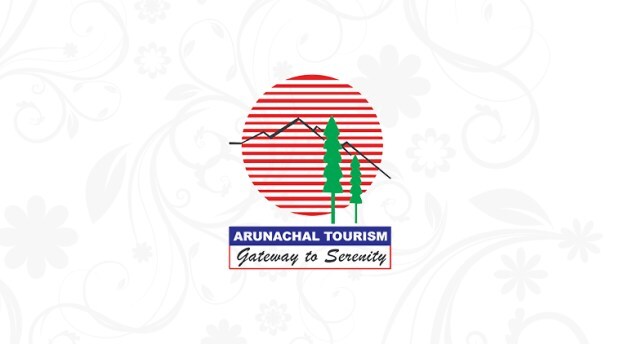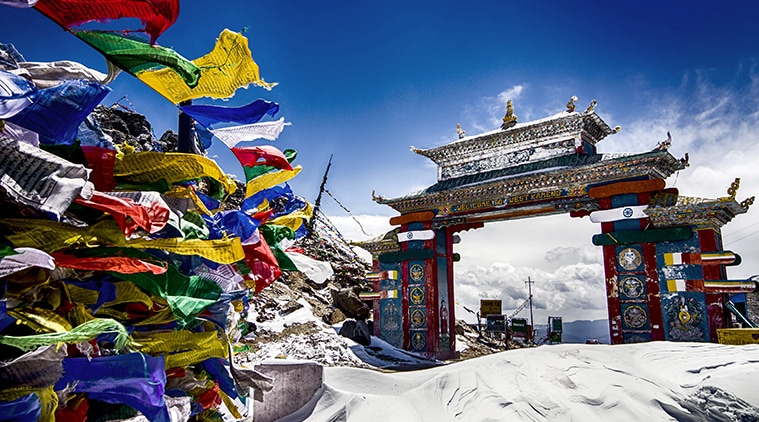- Itanagar
The state capital Itanagar is the biggest town in Arunachal Pradesh. The Jawaharlal Nehru Museum has on display some archaeological finds recovered from the 15th-century Ita Fort, which is also worth exploring. At the museum, browse amongst displays of ethnic arts and crafts, jewellery, textiles, and a variety of tribal headgear. The Nyishi people who live around here are distinctive for their massive knot of hair rolled into a bun over their forehead. Their headgear also features feathers of the great hornbill, Arunachal’s state bird. Visitors can pick up souvenirs at the Buddhist gompa and the craft emporium. A nice place to relax and stroll around is the Indira Gandhi Park. You can also visit the Ganga (Gyakatsinki) Lake close to the town outskirts. It’s a popular place for boating and picnics.
- Bomdila
The gateway to the legendary Tawang monastery, Bomdila, which is also the district headquarters of West Kameng, is a picturesque hill town in the Eastern Himalayas. It is home to the Sherdukpen and Monpa tribes. You can pick up some lovely carpets woven by the Monpas at the craft centre. Bomdila is a popular spot for short treks in the forest trails which offer gorgeous snow-peak views.
Trips to nearby Tipi, for its orchids, and Dirang, for its pretty gompas, come well recommended. There’s a yak breeding centre which can also be visited time permitting. A famous winter visitor in the black-necked crane.
- Tawang
Bomdila is the gateway to Tawang with its centuries-old fortified monastery, which is the stunning venue for the annual Losar festival. The dramatic drive along the winding highway takes one through the huge dragon gates of the Sela Pass (13,714 ft). Of interest here is Jaswantgarh, a memorial to a brave Indian soldier who singlehandedly made a heroic effort to deflect the Chinese from crossing over the pass during the 1962 Indo-Chinese war. The Tawang War Memorial also commemorates the fallen heroes of that war.
The Dalai Lama passed through Tawang on his escape to India from Tibet after the infiltration of the Chinese. The Tawang Monastery is said to be the second largest after Lhasa’s Potala Monastery.
The sanctum of the Tawang Monastery features a massive 8m-high gilded statue of Buddha. The library holds priceless manuscripts, scriptures and literature and the museum also has on display rare and beautiful tangkhas and ritual vessels along with some personal possessions of the 6th Dalai Lama. At the craft centre, you can buy colourful traditional masks, hand-woven carpets, and thangkas. jewellery and other mementoes.
The Urgelling Monastery, which features the footprints and fingerprints of the 6th Dalai Lama, is held in great veneration by the Buddhist community. Visitors can also make side trips to the nearby Pankang Teng Tso and Sangetser lakes.
- Ziro
Located on the Apatani Plateau, about 200km from Itanagar, Ziro is the district headquarters of the Lower Subansiri district. Blessed with a compelling natural beauty and a vibrant Apatani community, it offers travellers a wonderful insight into Arunachal’s rich ethnic traditions.
The annual Ziro Music Festival, in which foreign artists also participate, has contributed significantly to its popularity and promotion at home and abroad. The Apatani community is one of the most advanced of Arunachal’s ethnic people. Unmissable is the practice of face tattooing, distinctive as decoration for both men and women. The women folk also adorn themselves with great nose plugs (dat) made of bamboo. As opposed to the jhum style of cultivation by the Nyishis, the Apatanis grow rice by terrace farming and have an indigenous irrigation system which is quite unique to Arunachal’s ethnic practices. The women are reputed for their remarkable weaving skills. The Talley Valley with its Talley Valley Reserve Forest and Talley Wildlife Sanctuary, 30km from Ziro, offers an excellent opportunity to explore the rich bio-diversity of the region. The altitudinal variations support sub-tropical and alpine forests and a fantastic wealth of flora and fauna. Pleioblastus simone is a bamboo variety only to be found in Talley. Daporijo, 160km from Ziro, is the district headquarters of Upper Subansiri. Its great appeal lies in its spectacular natural landscape and rich tribal culture. The Museum and Craft Centre provide rich insights into its tribal pursuits. Adventure buffs can go white water rafting on the Subansiri River.

- Pasighat
Most people think of Pasighat (155m) as the jump-off point for white water rafting on the Siang River. But there is more to it than just that in this pretty town. It is one of the oldest towns in the state and serves as the district headquarters of East Siang.
On its journey to the plains, the Siang River is fed by the waters of the Dihang and Lohit rivers and arrives in Assam as the mighty Brahmaputra. Home to the Adi tribesmen Pasighat offers many insights into their rich culture. You may even get a chance to witness the popular Ponung dance. Pasighat has now evolved into a popular adventure sports hub. Daying Ering Wildlife Sanctuary is just 13 km away from Pasighat, and a delight to visit for its pristine forests, scenic views and rich flora and fauna. Mouling National Park is a beautiful 195km drive from Pasighat. Do explore this national park which is home to exotic species such as the red panda, clouded leopard, takin, serow, goral, etc. Birders will love it for its domestic residents and many migratory avifauna which come to visit in the winter. An unforgettable sight is the scenic Siang River which is the lifeblood of the park.
- Dehang-Dibang Biosphere Reserve
This superb biodiversity hotspot which sprawls over three districts—Dibang Valley, Upper Siang, and West Siang—is fed by the waters of the Dehang and Dibang rivers. Spread over 5,111 sq km it supports a wide range of flora and fauna. Both Mouling National Park and the Dibang Wildlife Sanctuary fall completely or partially within the Reserve’s confines.
The Mishimi Hills, home to the Mishmi tribe, are a prominent feature of the reserve. The valleys and foothills of the region are the habitat of the Idu Mishmi. Travellers can enjoy wildlife spotting, birdwatching trekking and hiking, tribal village visits, etc.
- Parasuram Kund
The Makar Sankranti Festival in the month of January witnesses a great influx of devotees. Steeped in mythology and veneration the famous kund, located on the Arunachal-Assam border, is closely associated with the legend of Sage Parasuram.
Provoked by his father to commit the sin of matricide Parasuram travelled the length and breadth of the country to assuage his guilt. Advised by the sages he arrived, in this remote spot to bathe in the kund. As he entered the water, the axe, which had been attached to his hand ever since the killing, fell away and cleaved the mountain in two, from which sprang the Lohit River.
- Dong
Arunachal Pradesh has long been feted as ‘the land of the dawn-lit mountains’. This legend has been underpinned by the fact that the first sunrise in the country can be witnessed in a small village here. That village is Dong, located in Anjaw District on the tri-junction of India, Myanmar, and China.
If you want to witness this phenomenon you have to leave Walong (7km), the base point of the 90-minute trek, well before dawn, and head to Dong to catch the sunrise. The trek involves crossing the Lohit River by a suspension bridge. Remember to go armed with your Inner Line Permit (ILP) to visit this remote spot.
- Roing
The district headquarters of the Dibang Valley is home to the Idu Mishmi tribe. You should take this opportunity to visit a tribesmen’s home and learn about their culture. About 30km away from Roing, Bhismaknagar is the site of the archaeological remains of the home of Rukmini, Lord Krishna’s wife.
The archaeological site of Bhismaknagar Fort, once a stronghold of the Chutias, is said to date back to around the 8th century. Rukmini was the daughter of King Bhismaka. The site continues to gather interest for its historical and mythological significance.
- Namdapha National Park
One of the world’s major biosphere hot spots, Namdapha National Park in Changlang district straddles the juncture of the Indian sub-continental-Indo-China bio-geographic region. Spread over 2,000 sq km, it is one of India’s most important, least penetrated biosphere expanses. It’s still a compelling scientific mystery as much of its botanical wealth hasn’t been surveyed because of its inaccessibility. Altitudinal variations range from the sea level of the valley floors to the snowy heights of 4,500 m. It is the only protected natural habitat where you will find all four big cats—the snow leopard, tiger, leopard and the clouded leopard. The best time to explore is in winter. Miao, near the Noa-Dehing River, is the gateway to the park. M’pen Checkpost is about 11 km away. The Deban Forest Bungalow is 28 km from Miao.
Miao district is home to the Tangsa, Singpho, and Lisu tribes. The Noa-Dehing River’s western bank has some small settlements of the Chakma tribesmen. The town has a Buddhist monastery, several Hindu temples and a few churches. Other attractions include a mini zoo, museum, Bishop House, and the Tibetan refugee settlement where one can pick up handmade wool carpets.

For more details about Green Tourism India Conclave, Click here.
